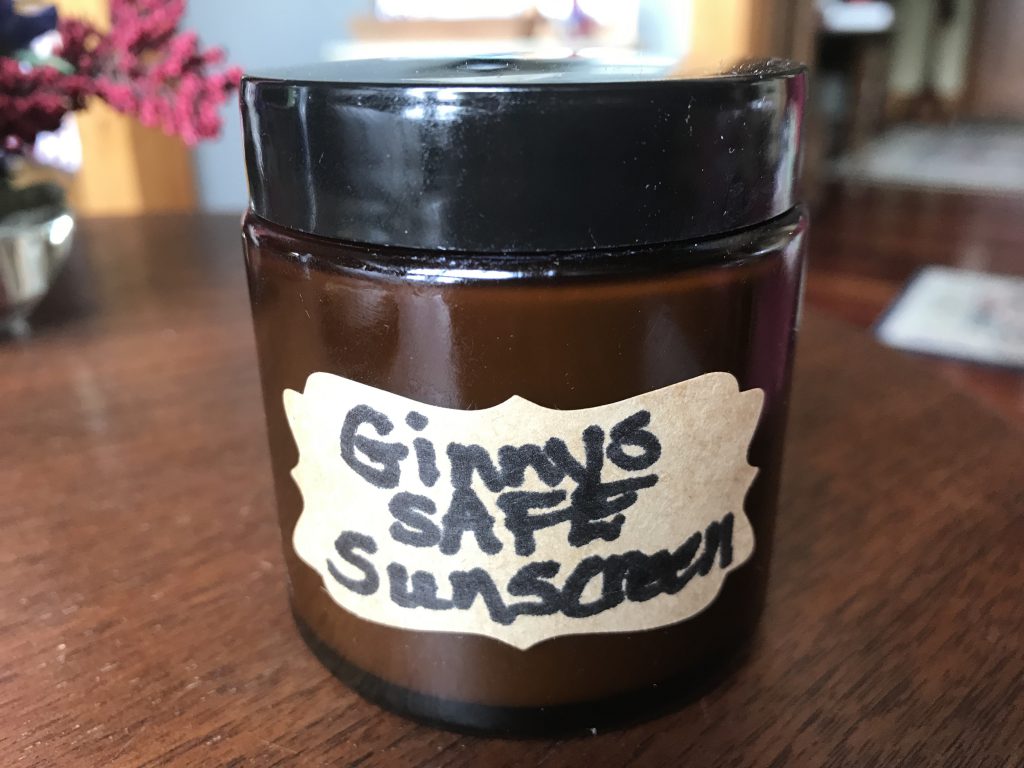A sunscreen with all the safe ingredients can be pricey. On top of that, the sun blocking ingredients lose their effectiveness within two years. Whether you make it or buy it and that sunscreen is working for you, use up what you have before you try another. Wise use is one way of keeping sunscreen AFFORDABLE and SAFE. You’ll be relieved to know there are AFFORDABLE and SAFE sunscreens on the market. And sometimes making your own is a great option.
The Environmental Working Group at EWG.org has a wealth of information about many products including sunscreens and their ingredients including pricing. Here is their list of Best Scoring Sunscreens. You can look up what you are currently using and see how it is rated. You can also find other ideas.
EWG’s Best Scoring Sunscreens for Kids
EWG’s Best Beach and Sport Sunscreens
EWG’s Best Beach and Sport Non-Mineral Sunscreens
Badger Broad-Spectrum SPF 35 Sport Sunscreen has been my preference for several years. It works great and for approximately 3 ounces, I paid about $15. It says on the tube that it contains non-nano zinc oxide as the sun blocking ingredient. It also contains sunflower oil, beeswax, vitamin e and jojoba oil. All of these are safe ingredients. I now use this when traveling. This sunscreen and all Badger products rank in the top category (1st ranking of 10) for SAFE sunscreens by EWG and are in an AFFORDABLE pricing category. Badger also makes a sunscreen for kids.

Recently, I made the following SAFE SUNSCREEN recipe for about $5 for 4 ounces. There’s a time to use homemade and a time to buy store bought. When traveling, I tend to use the Badger because the homemade turns to a liquid when about 72 degrees or above. This DIY recipe addresses all the ingredient safety concerns at an affordable price, and it took me about 10 minutes to make. I doubled the recipe and made four 4-ounce jars at one time. But this recipe should be refrigerated and the shelf life is only six months. It does not travel well, and it would need to go in your cooler when out boating or at the beach. You must also make sure the zinc oxide is mixed completely. If the mixture melts in the heat, you must stir again. It also takes some experimenting to see how much zinc oxide you should use for your skin type.

DIY Safe Sunscreen
Ingredients:
¾ cup of extra virgin organic coconut oil
2 TBSP pomegranate seed oil (or any combination from below)
2 TBSP shea butter
10 drops of lavender, frankincense or another essential oil
(However, do not use any citrus oil)
2 – 6 TBSP of powdered non-nano zinc oxide
1 – 2 TBSP of cinnamon or powdered raw cacao for tinting
You can add 2 TBSP of beeswax for waterproofing by reducing the coconut oil to 5/8 of a cup.
Directions:
Combine first four ingredients (can add beeswax) in a pint or quart glass Mason jar, and place that jar in a pan of water over low heat. Stir contents until mixed. Then add zinc oxide and choice of tinting until completely blended. Let cool at 70 degrees or cooler. You can store in your frig in glass jar or transfer to a hard plastic container with a screw-on lid. It’s best to apply sunscreen 15 minutes before you go outside. But if you take this homemade version out in the heat with you, it will turn into a liquid. Therefore, you will need to shake it vigorously before you apply it. That’s why I use the Badger when on the run. This sunscreen would not be one to take on a trip or cruise.
Pomegranate seed oil has an SPF of 25-30. There are also other natural sunscreens that you can substitute such as:
Red raspberry seed oil – SPF 28-50
Carrot seed oil – SPF 38-40
Wheat germ oil – SPF 20
Macadamia oil – SPF 6
Jojoba oil – SPF 4
The base of coconut oil has an SPF of 8. The pomegranate oil adds SPF, but it’s the zinc oxide that ups the SPF significantly. I experimented with 2 TBSP of zinc oxide only to find I needed 4 TBSP. Some people will need more. You can use the natural tinting to cut down on the “ghosting effect,” but the more zinc oxide, the more tinting you will need to add. Since the zinc oxide is a fine powder, many people recommended that it’s best to cover your mouth and nose with your shirt or a towel or bandana when mixing it in.

Don’t forget that we all need sun exposure to a certain degree. When we get adequate sun exposure, it can:
1. Supply our bodies with natural Vitamin D
2. Strengthen bones and prevent osteoporosis
3. Elevate mood and prevent depression, and
4. Improve cognitive function
We don’t want to be underexposed or overexposed. Just ask the folks who live in Alaska during the short days with minimal sunlight. Talk about lack of Vitamin D and depression.We need our Vitamin D! But if you are high risk or have previously had skin cancer, you are better off just taking the supplement. Vitamin D greatly reduces your risk of many cancers! Read my previous blog post on Vitamin D.
Sunscreen can be SAFE if you buy or use the right ingredients or products. I buy my Badger Sunscreen at Whole Foods or on Vitacost.com. Whether you make it or buy it, there are sunscreens that are AFFORDABLE and SAFE. Use wisely, and use up what you have before you open a new container. And find what works for you. If either homemade or a more natural sunscreen enables you to burn, it’s not right for you.
What sunscreens are SAFE and AFFORDABLE that work for you? Do any of you have a homemade DIY recipe to share? And speaking of chemicals on the skin–stay with me! In the next series of blogs, we’re going to be looking for chemicals you don’t want to put on or in your body in addition to those in some sunscreens.
For Your Health,
Ginny




